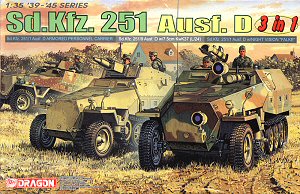Following on from their three kits of the Sd.Kfz.251 Ausf.C (kit #6187, 6206 and 6246) Dragon have now followed this with their rendition of the Ausf.D with the kit offering a choice of three variants to build, the basic 251/1 SPW, 251/9 7.5cm or 251/1 “Falke” IR vehicle. Just to clarify any confusion you can only build one vehicle from the parts in the box as one of the three choices offered.
The kit consist of 629 parts in light grey plastic with another 20 clear parts, 7 figure parts in a flexible vinyl, a small etched fret with 6 parts and metal barrel and ammo rounds for the 7.5cm KwK37 (L/24). Added to this are approximately 300 individual links and track pads for the EZ Track and three decal sheets plus the figure set #6089 Nachtjäger (Berlin 1945) for quite a box full. Also included are the original early type individual track links from the Ausf.C kits so you actually get two full sets of tracks to choose from.
Three of the sprues, C and D (x2), the lower hull tub and running gear are from the earlier Ausf.C kits with some parts not used here while all the rest of the kit is newly tooled for the Ausf.D kit.

The quality of the parts is excellent with crisp mouldings and details with only a minimum of pin marks to be cleaned up and there are a lot of plastic ‘nodes’ on the parts to be carefully removed especially from the smaller parts but these help reduce the amount of pin marks so are a small price to pay.
We will first look at the basic SPW and then look at the additional parts for the ‘Falke’ and 251/9
The lower hull tub as mentioned is the same as before and has the axles and bump stops separate with the front axle having nicely rendered leaf spring and steering arms. The drive sprockets being the same still don’t have the offset drive ‘teeth’ as they should and the front wheels have been altered with the inclusion of two rim fittings which seem attempts at balancing weights or valves but are quite over scale when compared to photographs.
There is the inner gearbox and fuel tank detail which still can’t be seen but you know it’s there right.
This has separate side panels with inner panel details as well as some large pin marks but these will probably be covered by the side storage lockers and seats but check first to see if they need filling. The upper hull is in one piece with separate engine bays doors and features with very subtle weld seams and bolts head details along the lower sides as well as nicely rendered flush screws around the engine bay opening and the rear inner grab railings along the upper sill. Test fitting of the hull parts shows the correct overhang of the hull and side walls but there is a small raised locating point on the left hull in front of the driver’s visor for a part from the “Falke” which you will have to remove for the other versions.
The outer side fender storage boxes have nicely rendered door details with recessed latch panels that also include small padlocks and two of the doors are separate to allow these to be position opened if you wish for a bit of animation. These attach to the forward fenders that have subtle bolt head details and other details such as three part head light and mounting as well as the exhaust muffler on the left fender with the width indicators and rear view mirror that includes a self adhesive silver sticker to represent to mirror surface and lastly the fender mounted tools that are quite nice but could benefit with the clips replaced with etched items for more detail definition.
The separate rear doors and rear hull panel are fairly simple as per the original and the doors feature finely moulded separate inner door latches with etched handles and fire extinguishers on the inner rear panel.
The front superstructure plate with driver’s/radio operator’s vision visors is a separate part and features clear parts for the visors which are made up of three inner parts and the outer visor which can be assembled so the outer visor is movable and if care is taken during assembly would work quite well to offer more animation to the finished model.
The upper superstructure plate is also separate and has the two underside padding panels as well as the central grab handle and separate bullet splash guard which is slightly heavy but could be thinned a little quite easily.
The machine gun shield is provided in plastic as well as in etched metal depending on your choice with MG42s supplied for the front and rear mounts.
One the inside is the lower floor panel with the central gearbox hump which
seems quite a bit under sized compared to photos and very subtle tread
plate pattern.
The side troop seats have separate lower frames and you get a choice of early
leather covered or later wooden slat bench seats and the under seat storage
boxes.
The upper storage boxes have racks for the eight separate and nicely moulded
Kar98 rifles with room for any other equipment you want.
The front instrument panel is redesigned with nicely detailed engraved instruments and some parts separate that were included on the instrument panel moulding in the Ausf.C kits as well as separate accelerator pedal and steering wheel and nicely detailed crew seats with rear spring details, gear levers and the separate bolted flanges on the side walls between the front and rear hull sections.
The kit as mentioned contains two full sets of tracks, the initial type track
(skeletal with lightening holes) with rubber shoe as came with the Ausf.C kits and the new “EZ Track” which is the pressed pattern with
rubber shoe and while less common than the skeletal was till widely used.
The EZ Track links and separate shoes come already separated with no cleanup
required apart from two largish pin marks on the inside of each track link
which will require filling but as there is no sprues or other cleanup they
would probably take about the same time as “normal” plastic individual
links to assemble but the rubber shoes do look a little undersized.
Assembly is the usual method for this type track where you fit one link into the other and hold in place with the track shoe, but due to the small size there isn’t a lot of contact area to glue and care should be taken if you want them to fully articulate after assembly with the assembled tracks fitting snugly around the drive sprockets and provide a nice alternative to the early track, not to mention a full set of track left over for other projects no matter which you choose.



Original early type track links


Overall a nice rendition of the 251/1 Ausf.D with plenty of details and only a few areas where attention is needed.
This vehicle was produced to provide infantry support for the Sd.Kfz.251/20 “Uhu” and IR equipped Panther Ausf.Gs and were in fact converted from the /20 “Uhu” by removing the large internal generator and upper IR searchlight while still retaining most of the features of the “Uhu” such as the two upper side walkways, rear reinforced flooring and internal stowage layout. The stencil data block provided on the decal sheet correctly identifies the vehicle as an Sd.Kfz.251/20 which is good to see.
The kit is basically the same as above with alterations for the ‘Falke’.
Dragon has supplied the clear IR parts from their Panther G kit which are
slightly undersized and should also be altered for the ‘Falke’ plus
additional parts in grey plastic for the radio equipment and side wall
power supplies and there are a few holes needed to be opened up in the
hull for the IR sight and relocated front mounted aerial.
One issue with the Falke version is that as the initial Falke vehicles were converted from the 251/20 UHU there should actually still be the raised rear section that was lifted by 50mm to include additional bracing for the large searchlight turntable base but just the standard floor is included.
The new plastic parts for the Fu5 radio and radio/power equipment are nicely done with crisp details with the Fu5 radio fitting centrally under the top plate (part C5) and the radio/power equipment fitting on each sidewall as indicated in the instructions, there is quite a bit of wiring/cabling connecting these and the IR sights that could be added for more detail but you will have to provide this yourself.
The front right troop seat is left out to make space for the equipment as shown in the instructions and the right rear seat should also be replaced with a three locker storage bin as per the ‘Uhu’ but this isn’t included in the kit while the small multi-part ‘dickie’ seat is provided and located on the left wall just behind the driver’s seat.
Small alterations are required on the top plate (part C5) with the central grab handle supplied (part A41) not fitted in most photos and two smaller handles added under the plate above the crew seats. The bullet splash guard is also a rectangular cast guard on some ‘Falke’ vehicles but the rounded guard in the kit is also seen in some photos so is perfectly okay.
The top mounted Fg1250 IR sight includes the front illuminated gunner’s
graticule as fitted to the Panther sight and is mounted on a new plastic
mount which is an improvement on the mount in the Panther clear parts as
well as the MG42 to finish off the assembly and as mentioned there is some
additional cabling to be connected if you wish.
The driver’s Fg1252 IR sight shouldn’t have front illuminated
gunner’s graticule and the front raised section of the sight can be
cut off with the sight and added searchlight fitting into the holes opened
up in the hull top.
At the hull front is the mounting bracket for the second IR searchlight with the mounting in grey and the light in clear plastic with separate front section and again there is some cabling to be added to this light if you wish.
Part S14, a small part on the top left hull just in front of the driver’s visor is a simple rectangular piece but in fact should be a hollow triangular shaped guard which protects the cabling for the driver’s Fg1252 IR sight as it enters the hull through an opening behind the guard and not through the driver’s visor as commonly thought.
Finally there are the wooden walkways along the upper hull sides that are fitted to the “Uhu”, and carried over to the majority of “Falke” conversions but unfortunately these are not included in the kit but could be made from thin card without too much trouble.
Overall Dragon have done a reasonable job with the ‘Falke’ conversion with the new plastic parts having nice details but the recycled Panther parts need some attention with other equipment and fittings needed for a fully accurate ‘Falke’.
The Ausf.D 7.5cm KwK37 in the kit is the late type which had a raised superstructure above the hull leaving the front plate with the driver’s visors intact and these were often just simple flat plates on these late vehicles and the right side visor was replaced with a solid flat plate without visor as the gun controls took up all room on that side of the hull, this feature unfortunately is not depicted in the kit with only the standard visor provided for the right side.
Again the basic vehicle is assembled as above with the new parts for the /9 being nicely moulded with crisp details and include the full gun assembly and internal ammo storage and you have to remove the locating marks for part S14 on the upper hull as with the basic kit.
The interior of the standard SPW is modified by leaving out the front two troop seats and replacing the left rear seat with the large ammo storage box supplied which has a separate lid showing the base of the stored rounds in the box while on the right wall is a rack containing the six plastic 7.5cm rounds supplied as well as the radio and other equipment on the left wall all of which is quite well represented by the kit parts.
The gun assembly is quite comprehensive with the main gun having a two part breech assembly with separate breech block and a choice of plastic or metal 7.5cm barrel as well as separate gun controls.
The large breech guard is in two halves with nice details and includes the lower shell catcher and gun mounts and forward mantlet but there are a few pin marks on the inside of the solid guard to be dealt with. The full cradle for the co-axial MG42 is also provided along with the gun for good detail definition.
The upper superstructure is in two halves with nice holt head details on both sides and only one shallow pin mark on the inside corner which would probably be hidden once the gun is fitted and the superstructure attaches to the new upper hull plate and the gun is secured with a small grommet underneath and so will traverse after assembly.
There are also the three metal 7.5cm rounds provided to be used as you wish
to dress up the finished model.
Again this is quite a good representation of the late model Kanonenwagon
with all the main alterations there with the right side visor cover being
about the only thing that requires major attention.
This kit includes a new soft vinyl driver figure and soft vinyl overcoat and boots to use as extras.
The details on the driver figure are crisper than the usual hard plastic figure but there are also the moulding seams that will be quite difficult to remove from this material. The parts don’t react to normal liquid or tube plastic cement and you will have to use cyanoacrylate for the job. While the material is flexible you can only expect to bend the lower halves of the legs and arms as the rest of the figure is too thick to bend. The vinyl overcoat is huge and is more 1/32-54mm in size than 1:35th scale but this may not be noticed if the coat is just laying about in a diorama setting and has good details included.
Also included is the figure set #6089 Nachtjäger (Berlin 1945) with associated weapons to use in a diorama setting if required.
These are of the traditional exploded line drawing view type with easy to follow construction sequences but as with any kit careful study of the instructions before gluing is advisable.
Included in the kit are three decal sheets, a large sheet with no less than 15 vehicle markings as well as series of vehicle numbers in Black w/white outline, red w/white outline, blue w/white and plain black plus some stencil data blocks for an almost endless choice of markings.
The second sheet is a generic number plate set with plain front and rear plates with a selection of numbers to again make just about any Wehrmacht 251.
The other small sheet has the divisional insignia for the vehicles shown on the instruction sheet.
The decals are well printed with closely cropped carrier film and should react well with decal setting solutions.
Markings include 11 x 251/1s, 2 x “Falke” and 2 x 251/9 vehicles for a good selection of markings
Sd.Kfz.251/1 Ausf.D
- a. Unknown Unit, Western Europe 1944 in three colour ambush scheme.
- b. Polish Forces “Starówka”, Warsaw 1944 in two colour scheme. This is 251 captured during the uprising and features the Polish Red/White insignia on sides and back and large white Polish Eagle on the front plate.
- c. PzGrenDiv “LAH”, Kharkov 1943 in overall White scheme.
- d. 5.PzDiv “Wiking”, East Prussia 1945 in Dark Yellow/Green scheme.
- e. 5.PzDiv “Wiking”, Eastern Front 1944 in overall Dark Yellow.
- f. 5.PzDiv “Wiking”, Warsaw 1944 in in three colour wavy pattern scheme.
- g. 12.PzDiv “HJ”, Belgium 1944 in three colour scheme.
- h. 12.PzDiv “HJ”, France 1944 in three colour scheme.
- i. PzGrenRgt.25, Normandy 1944 in three colour scheme.
- j. Unknown Unit, Bohemia 1945 in three colour scheme.
- k. 97.InfDiv, Bohemia 1945 in three colour scheme.
Sd.Kfz.251/1 Ausf.D “Falke”
- a. Nachtjäger Unit, 1945 in three colour scheme.
- b. Unknown Unit, 1945 in three colour scheme.
Sd.Kfz.251/9 Ausf.D 7.5cm KwK37 (L/24)
- a. Unknown Unit, 1944 in overall Dark Yellow.
- b. 20.PzDiv, Russia 1944 in three colour scheme.
Each vehicle has a side, front and back view diagram showing the decal placement and cam scheme layout to help finish your chosen model.
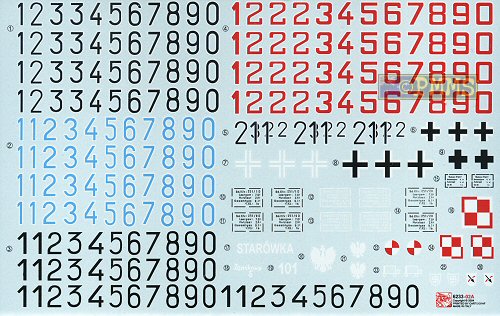
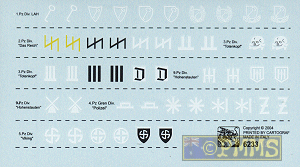
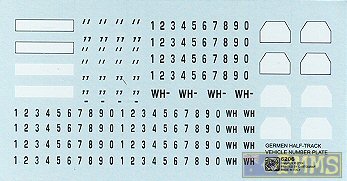
I always worry when I see a kit offering multiple versions in the one box as there are often shortcuts and compromises made to get the different versions but as Dragon chose three versions that don’t have a lot of deviations from the base vehicle there was really only the fine details to worry about.
Overall the kit has some nice crisp details with plenty of multiple choices in the basic kit such as the open side storage boxes, two complete sets of workable track, early and late style bench seats and etched or plastic gun shield and plenty of markings choices.
There is some additional detailing needed mostly on the ‘Falke’ but these would probable still be needed if the kits were released as separate kits and Dragon have done a good job on the combined variants.
Also of interest is that Sprue S is labeled Sd.Kfz.251/D 20 so it seems we can expect a kit of the 251/20 "Uhu" in the near future.
A full blow by blow comparison review with the AFV Club Sd.Kfz.251/1 Ausf.D and 251/9 will follow shortly to highlight the pros and cons from each kit but the overall winner is without doubt the modeller.
Click on thumbnails for larger view










Close new window to return to review
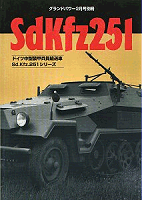 SdKfz251 Ground Power Special GALILEO Publishing Co.,Ltd |
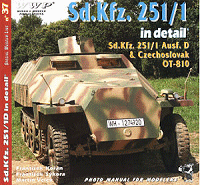 Sd.Kfz.251/1 in detail Special Museum Line No.37 Wings & Wheels Publications ISBN 80-86416-50-X |
 Sdkfz251 Ausf.C & D Panzer Tracts N0.15-3 ISBN 0-9771643-5-7 |
 Sd.Kfz.251/1 Ausf.D Model Detail Photo Monograph No.22 RossaGraph ISBN : 83-89717-60-3 |
 Sd Kfz 251 Tank Power Vol.VI Wydawnictwo Militaria No.215 ISBN: 83-7219-215-4 |
 Sd Kfz 251 Tank Power Vol.X Wydawnictwo Militaria No.224 ISBN: 83-7219-224-3 |
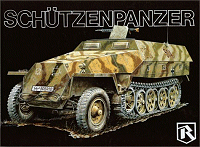 Schutzenpanzer (Armored Personnel Carrier) Ryton Publications ISBN: 1930571291 |
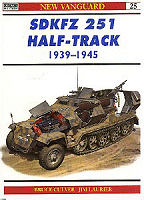 Sdkfz251 Osprey New Vanguard 25 |
 SdKfz251 in action Squadron Signal #2021 |
Thanks also to Hobby Easy for the quick delivery of the review kit.


